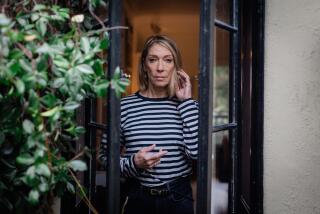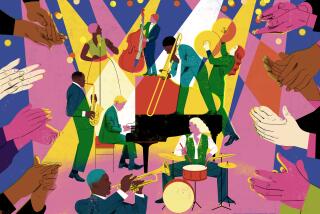Go, stop, order, chaos: the rhythm of Los Angeles
What is the rhythm of Los Angeles?
Before hearing poet Wanda Coleman speak at the Los Angeles Central Library recently, it had never occurred to me to think that L.A. has a rhythm.
Coleman is an L.A. native whose poems have taken her around the world as an ambassador of Angeleno attitude. She shared the stage at the library’s “ALOUD” lecture series with another great L.A. poet, Lewis MacAdams. When you leave L.A. and come back, Coleman told us, you feel the unique way time and people move here.
Every great metropolis has a rhythm. Hear the trilling clarinet of Gershwin’s “Rhapsody in Blue,” and you are in New York. Paris is the longing of an Edith Piaf song.
Finding L.A.’s rhythm isn’t going to solve our budget crises or rescue our schools or the housing market. But we Angelenos are more than the sum of our problems.
We are workers and creators, thinkers and gardeners. From our interactions, a melody or a cacophony is born. Allow the city’s rhythm to seep into your brain, and life here is bearable. So when I had the chance, I asked Coleman and MacAdams what, exactly, L.A. sounds and feels like to them.
“There are people who have come and translated the sounds I hear into music,” Coleman answered. L.A. jazz greats like Stix Hooper, Charles Wright and the Watts 103rd Street Rhythm Band, and Grover Washington and his album “Winelight.”
“That’s what L.A. sounded like when I was in my 20s,” said Coleman, 65. “Dah-dah-dat, dah-dah-dat, dah-dah-dah.”
In the present, given L.A.’s “juxtaposition to Mexico,” Coleman said she feels the city’s rhythm in “the African-influenced music that comes up out of Central America and Mexico.”
To this sonic stew, MacAdams said we should add the album “Los Angeles” by the band X: raw, alienated, hard-driving, fierce and alive. And finally, Coleman mentioned the Red Hot Chili Peppers’ “Under the Bridge,” a song about wandering L.A. alone, finding solace in the city’s streets and hills — the perfect anthem, I think, for a city filled with loners.
Jazz, cumbias and the assorted varieties of rock ‘n’ roll: Can we say that all those different sounds meld into a single rhythm?
Clearly, the great diversity of L.A.’s people and the constant cultural mixing that takes place here are part of what defines the city’s rhythm. L.A. is a radio scanning between languages and genres, a pastiche of sounds and attitudes.
Many an L.A. poet has labored to capture this feeling in verse.
In a poem called “Moguls and Monks,” MacAdams describes the movement of his eyes as he drives past a stoplight near the Paramount Pictures studio in Hollywood. Through his windshield, he sees a movie mogul pass in a “dollar-green Cadillac limousine,” while two Buddhist monks wait to cross Gower Street.
MacAdams writes: “Though they don’t see each other, I am them both / as I turn up Highland, cruising…”
Reading this, I thought: Now that’s a quintessentially L.A. moment, the ambitious and the spiritual sharing an intersection, both seen from behind the wheel of a moving car.
I found that poem in “Poetry Loves Poetry: An Anthology of Los Angeles Poets,” a book recommended to us by the host of the library event that evening, Lynell George.
“Poetry Loves Poetry” was published in 1985. The 1980s, I would argue, were when the modern, conflicted rhythms of L.A. were born. Our biggest booms were behind us then, immigrants were starting to change the city. It was getting more complicated to live here, less comfortable — and maybe more interesting.
Peter Schjeldahl finds the city’s rhythm and feel in “On Pico,” a poem dedicated to the boulevard of that name.
You have a dustily marginal air
You seem immunized against the showy…
You look unphotographed
You are unthronged…
You are the back of the turned back of the city…
You jerk through the city, stoplight to stoplight, light like a blunt knife through an unfeeling body.
The words of the poets stuck with me as I drove through L.A. this week to a variety of meetings and assignments: from downtown to Beverly Hills, and from South-Central back to my home in Mt. Washington.
The rhythm of L.A., I thought, can be found on the Santa Monica Freeway: It’s there in the way our eyes shift from window to mirror as we cross three lanes, or attempt to, during those 60 seconds when traffic is moving at 60 mph, until suddenly, and without explanation, it is not moving at all.
And the rhythm of L.A. is there to be seen on foot, in my neighborhood. It’s in the slow, circling glide of the crows, and in the crawl of the spiders patrolling webs built in unmoving jade plants. It’s there in the sunflower plants my neighbors are growing, their green stalks an inch or two taller every morning when I leave for work.
The rhythm of L.A. is two brawny softball players standing patiently in two center fields, in the two baseball fields back-to-back in a city park — with a soccer game of sweating middle-aged Spanish speakers squeezed between them.
And it’s there, most powerfully for me, in the memory of the coyote I saw some years ago, walking up the Avenue 43 exit of the Pasadena Freeway.
The coyote advanced on the asphalt with a bouncing gait, in a hurry but unafraid, his movements silky and savage. He was there one moment, and then gone, like a phantom, a vision of the wild in a city of stucco and concrete.
We live in a place where desert and metropolis meet and overlap. Everything collides and mixes here: the flora and fauna, the music and the languages we speak. There’s a visual and aural splendor created by all these collisions of man and nature. Call it, if you will, the rhythm of L.A.
More to Read
Start your day right
Sign up for Essential California for news, features and recommendations from the L.A. Times and beyond in your inbox six days a week.
You may occasionally receive promotional content from the Los Angeles Times.







